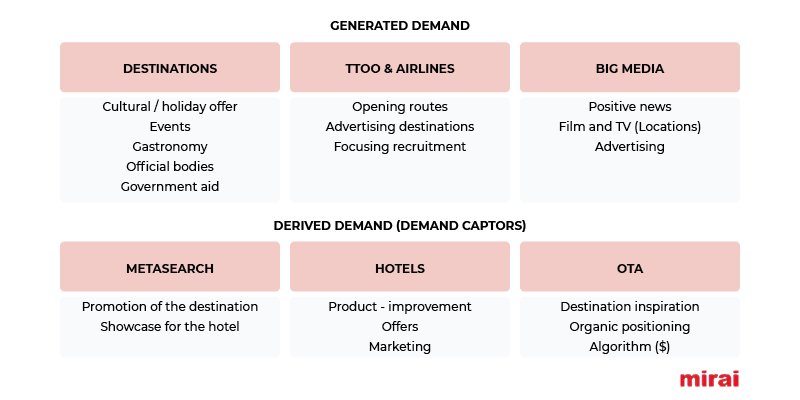Do OTAs generate demand? Can my hotel create demand if I close my eyes and clench my fists tightly?
NB: This is an article from mirai, one of our Expert Partners
Subscribe to our weekly newsletter and stay up to date
In the following post, we will try to shed some light on the concept of demand, delving into how it works and how you can make use of it to benefit your establishment.
Generating Demand: Who is responsible?
Hotels do not generate demand by themselves. With this said, we could end the article here since this is the most important lesson you should take away from today. Only in very rare and exceptional cases (such as with the Ushuaia in Ibiza, which actually helps generate demand in the destination) does a hotel itself generate demand.
To understand what the hotelier’s radius of action is in relation to demand, let’s draw a line between the two sides. On the one hand, we have demand generation, where hotels have no influence, and on the other hand, we have demand “capture”, where the hotel competes with other channels and hotels to capture the generated demand. It is in this area that you should focus your strategy because this is where you can make a difference.

Demand generators
These are the main drivers of tourism demand and although they usually have a positive impact, they can also have the opposite effect. They can act on a stand-alone basis, or they can partner with other demand generators or demand aggregators. They can mainly be divided into:
-The Destinations
Tourist destinations are perhaps the most direct factor in demand generation. The cultural and holiday offerings, special events, gastronomy, and the initiatives of official bodies and governmental aid, play an essential role.
For example, the attraction of international events, such as music or sports festivals, can significantly increase visitor numbers at specific times of the year. The promotion of unique and high-quality culinary experiences also attracts specific tourists, who are looking for experiences that are more linear in time. The hotel and complementary offer are closely linked to the destinations and can be allied with them.
– Tour Operators and Airlines (and other transport)
Tour operators and airlines have a considerable impact on demand generation through the opening of new routes, advertising destinations and centralising bookings.
Airlines, by opening new connections, make it easier to reach destinations that were previously less accessible, which in turn can significantly transform tourism demand. Similarly, tour operators, by creating attractive and affordable packages, can channel large numbers of tourists to specific destinations.
Again, the hotel can ally itself with these demand generators and secure part of that share for itself.
– Big Media
Information in the media about a destination or advertising can be decisive when it comes to boosting visits to a place, and this is becoming increasingly important. It can have both a positive and a negative impact.
Here we are not only referring to the press, with television, cinema and social networks also acting as major generators of demand (screen tourism already moves around 100 million tourists a year, with a prime example being the Game of Thrones series in Spain). For Generation Z, social media has already overtaken Google in terms of looking for travel inspiration, with this trend continuing to grow day by day.
The good news? Social media is perhaps the most accessible demand generator for establishments and its organic model is one of the most affordable as well.
Generated Demand vs Derived Demand
Generated demand comes from the actors mentioned in the previous point, while derived demand refers to how hotels and other entities in the sector capture and exploit this demand.





